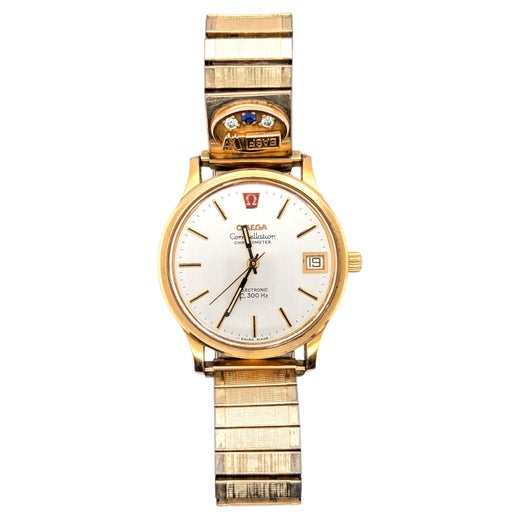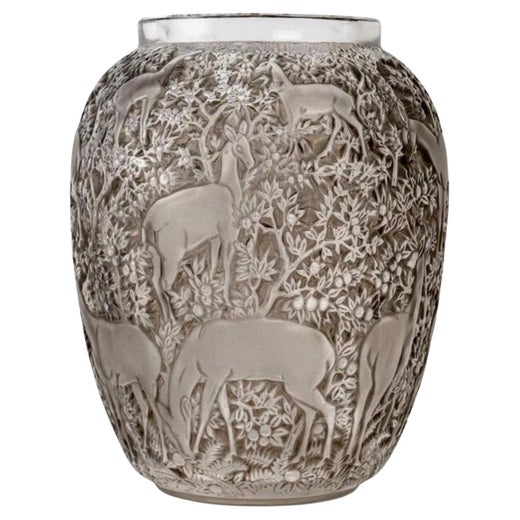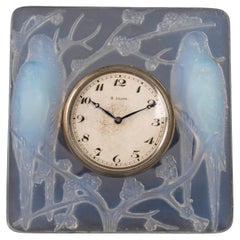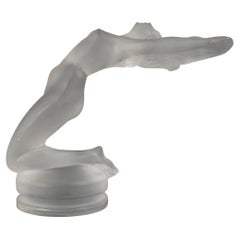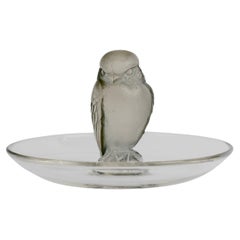1931 René Lalique Clock Roitelets Frosted Glass Enamel Dial Omega Movement Birds
About the Item
- Creator:René Lalique (Artist),Omega (Clockmaker)
- Dimensions:Height: 7.88 in (20 cm)Diameter: 7.09 in (18 cm)
- Style:Art Deco (Of the Period)
- Materials and Techniques:Glass,Molded
- Place of Origin:
- Period:
- Date of Manufacture:1931
- Condition:
- Seller Location:Boulogne Billancourt, FR
- Reference Number:1stDibs: LU3878331089462
Omega
It’s a celebrated part of Omega lore that the brand’s Speedmaster Professional Chronograph was the first watch to make a lunar landing. But the universal love for vintage Omega watches isn't confined to astronomers, and there’s more to the company’s heritage than the story of the Moonwatch.
The house’s origins date to 1848, when Swiss watchmaker Louis Brandt first set up shop. His sons Louis-Paul and César took over after his death, and in 1894, the pair developed an intriguing new movement.
Not only was it highly accurate, but every part was replaceable, making it easy for any professional to service. The Brandts called their movement the Omega, and as its popularity spread, they changed their company’s name to that of its flagship product.
In 1917, the British Royal Flying Corps designated Omega as an official supplier, and during World War II it became the principal watch supplier for the British forces and their allies. These commissions further strengthened Omega’s commitment to ensuring its products’ reliability under extreme conditions. In 1948, it launched the versatile Seamaster. Developed as a dive watch, the Seamaster proved its durability at high altitudes and freezing temperatures, as well. (Here is the 1stDibs guide to spotting a fake Omega Seamaster.)
Thanks in part to its rugged reputation and Omega’s links to the British military, it became James Bond’s watch of choice in 1995, appearing in GoldenEye and every succeeding Bond movie; it returned in 2021’s No Time to Die. Nevertheless, the most famous Omega by far is the Speedmaster, introduced in 1957. The first chronograph to display its tachymeter scale on the bezel instead of the dial for easier readability, it was quickly adopted by engineers and scientists.
Worn by Buzz Aldrin during the 1969 Apollo 11 lunar mission, it’s the only watch certified by NASA for extravehicular activity (space walks) — and, as far as we know, the only one approved by the Russian space agency, too.
Watch aficionados and aficionadas alike can find vintage Omega watches today on 1stDibs.
René Lalique
The career of the famed jewelry designer, glassmaker and decorative artist René Lalique spanned decades and artistic styles. Best known today for his works in glass, Lalique first won recognition for his jewelry. He was described as the inventor of modern jewelry by the French artist and designer Émile Gallé, and his luxurious naturalistic designs helped define the Art Nouveau movement. Later as a glassmaker in the 1920s and ‘30s, Lalique designed vases, clocks, chandeliers and even car hood ornaments that were the essence of Art Deco chic. Even now, the name Lalique continues to be a byword for a graceful, gracious and distinctively French brand of sophistication.
Born in 1860 in the Marne region of France, Lalique began his career as a jewelry designer in the last decades of the 19th century. His work employed now-classic Art Nouveau themes and motifs: flowing, organic lines; forms based on animals, insects and flowers — all rendered in luxurious materials such as ivory, enamel, gold and semi-precious stones. By 1905, Lalique had begun creating works in glass, and his style began to shift to a cleaner, sharper, smoother, more modern approach suited to his new medium. His Paris shop’s proximity to perfumer François Coty’s led him to experiment with beautiful perfume bottles. He offered the first customized scent bottles, transforming the perfume industry. By the end of the First World War, the artist had fully embraced Art Deco modernity, devoting himself to new industrial techniques of glass production and designs that manifest the sweeping lines and the forms suggestive of speed and movement characteristic of the style. Lalique’s work looked both backward and forward in time: embracing ancient mythological themes even as it celebrated modern progress.
Late in his career, Lalique took on high profile luxury interior design projects in Paris, Tokyo and elsewhere. He designed decorative fixtures and lighting for the interior of the luxury liner Normandie in 1935, and decorated the salons of well-known fashion designer Madeleine Vionnet. Today, Lalique’s influence is as relevant as it was when he opened his first jewelry shop in 1890. In a modern or even a traditional décor, as you will see from the objects offered on these pages, the work of René Lalique provides the stamp of savoir-faire.
You May Also Like
Vintage 1930s French Art Deco Mantel Clocks
Glass
Vintage 1930s French Art Deco Carriage Clocks and Travel Clocks
Art Glass
Vintage 1930s French Art Deco Carriage Clocks and Travel Clocks
Art Glass
Vintage 1920s French Art Deco Mantel Clocks
Art Glass
Vintage 1920s French Art Nouveau Table Clocks and Desk Clocks
Chrome
Vintage 1920s French Art Deco Carriage Clocks and Travel Clocks
Blown Glass
Vintage 1920s French Art Deco Table Clocks and Desk Clocks
Glass
Vintage 1920s French Art Deco Glass
Glass
Vintage 1930s Vases
Glass
Vintage 1920s Mantel Clocks
Glass
More From This Seller
View AllVintage 1920s European Art Deco Table Clocks and Desk Clocks
Glass
Vintage 1930s European Art Deco Figurative Sculptures
Blown Glass
Vintage 1930s French Art Deco Figurative Sculptures
Blown Glass
Vintage 1930s French Art Deco Decorative Dishes and Vide-Poche
Blown Glass
Vintage 1920s French Art Deco Vases
Blown Glass
Vintage 1920s French Art Deco Decorative Boxes
Blown Glass
